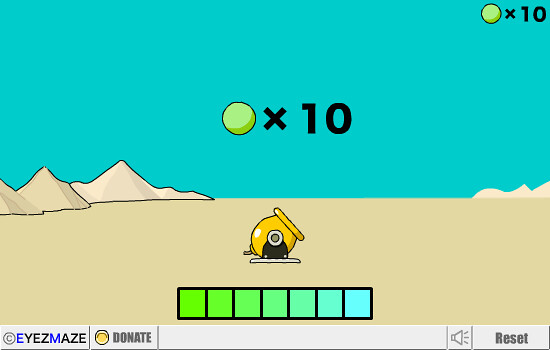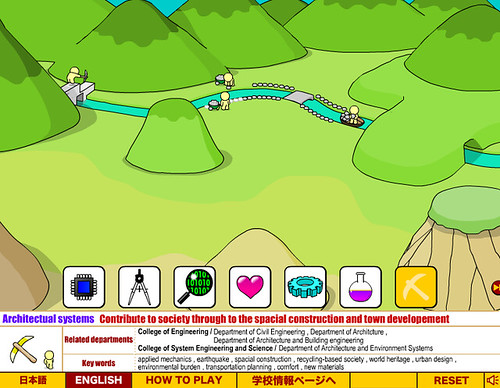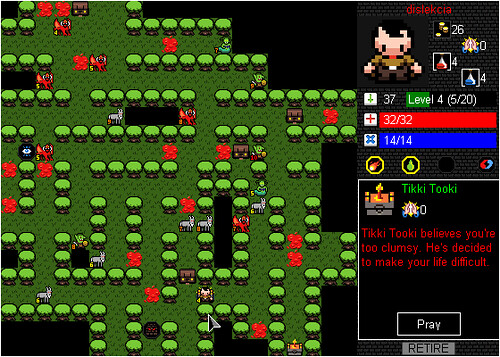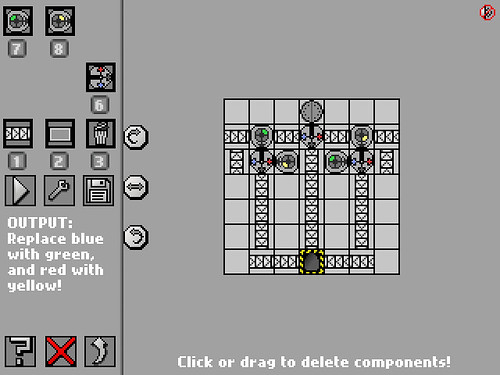Posts from ‘Puzzle’ Category
Grow Cannon
By: Derek Yu
On: January 31st, 2011

Awesome, a new Grow game from Japanese developer “On”! In Grow Cannon, you’re trying to wake someone who’s sleeping heavily. Fire the cannon at seven spots in the right order to win! Simple, cute, and fun.
TIGdb: Entry for Grow Cannon
suteF
By: ithamore
On: January 25th, 2011
[This is a guest review by John Sandoval. To submit a guest article for TIGSource, go here.]
Edit: You might want to avoid the video if you don’t want to see any spoilers. /Edit
Nothing is as it seems in the world of suteF. Though what you see is a fairly standard puzzle-platformer (crates are pushed, ledges are climbed, and exits are ultimately reached), suteF is at its core a game that takes every opportunity to mess with the player as much as possible. A miscalculated jump can trigger cracks in reality; a single step could erase your path from existence. Entire dimensions can open up from the void. And this tension, this uncertainty, this feeling that anything can happen at any time, is what makes playing suteF an experience worth having.
The successor to creator Ted Lauterbach’s earlier work (titled Fetus), suteF places you once again in the role of an admittedly doughy little blue man named Aramas. Trapped in a hellish dimension, you must progress through five sets of levels, using your wits and Aramas’ limited skillset to solve increasingly complex puzzles and hopefully find a way out. Aramas has at his disposal three individual abilities— jumping, crate pushing, and grappling onto nearby surfaces with his trusty grappling hook. However, the game takes great delight in stripping you of any of these abilities when you least expect it, keeping you on your toes. In addition to Aramas’ inherent abilities, your greatest asset in escaping the world of suteF comes from the warped nature of the dimension itself. To put it simply, walking off one end of the screen leads you to the other; falling off the bottom of the screen loops you back to the top. Exploiting these spatial impossibilities can turn an otherwise impassable chasm into a mere few steps in the other direction. The resulting puzzles are exceptionally clever, forcing the player to make full use of all of Aramas’ paltry abilities in a multitude of ways. You’d be surprised just how much gameplay suteF ekes out of these relatively simple mechanics.
Every element in suteF is crafted to make the player feel as if the world could tear apart at any moment. From the constant screen static to sudden changes in the levels themselves, you’re never sure if what you’re playing is a glitch or the actual game. Some might call this a lack of polish—but I feel that the game is far more interesting for it.
suteF is available for download from GameJolt. It takes about one to two hours to beat; the various secret levels can double that time. All in all, it’s a very, very good game.
NightSky
By: ithamore
On: January 9th, 2011
The PC version of Nifflas’ NightSky is still available for $7.20, but today is the last day to buy it at this discounted release price. Tomorrow, the price will be raised to $10.
If you’ve been looking forward to the PC version, now’s the time to try out the demo if all the previews, reviews, and videos out there weren’t convincing enough for you to have purchased it already. However, if you would prefer to express you enjoyment of and delight in NightSky and Nifflas’ other games by waiting for the $10 price, you also have that choice as a means of expressing your gratitude.
Temporal
By: Derek Yu
On: December 14th, 2010
[This is a guest review by snowyowl. To submit a guest article for TIGSource, go here.]
Temporal, by Renbo, is a puzzle platformer about a robot trying to get out of a space station laboratory. It’s not a new game (it was released in October 2008, and the Tick Update was in July 2009), but it hasn’t received as much attention as it deserves, so… let’s review it!
It’s a time travel game at heart, so if you liked Chronotron, Braid, or any similar games, you’ll love this game. The puzzles are original, the story is gripping, the jokes are funny, and it’s free to play too. It also has online leaderboards.
Nimbus
By: Lorne Whiting
On: October 26th, 2010

So, puzzle/action game Nimbus was released on Steam (for ten bucks) yesterday. It’s pretty damn fun. You pilot a spaceshipy thing with no internal propulsion system glider shaped like a spaceship, meaning you have to rely on the environment and gravity to move. The barebones plot has you struggling to rescue your ship-mate– Err, mate who is a flying ship.
It’s pretty simple gameplay wise, controlled entirely with the arrow keys. It’s also billed as a racing game but getting a good time is entirely optional and it definitely seems more puzzley. While it starts simple– straight-forward navigating to the exit –more elements are added to the levels and it becomes harder and harder to retain precious momentum or avoid spikes and lasers, growing quite challenging. There’s also tons of unlockables, in the form of trails and different ships, and unlocking them requires secret items (giant coins and hidden levels!), which range in placement from the simple 10-feet out-of-reach to brain-rackingly difficult to get to.
The game is very polished, and it’s difficult to fault it for anything; the failures are fair and the challenges are well, just part of the challenges. On a different note: there’s strangely almost no information on the developer’s, Noumenon Games, website, but… eh, too bad. It’s fun.
There’s no demo, sadly, but it’s easily worth the $10 if you’re willing to make the leap-of-faith.
PAX 2010: The Witness
By: Derek Yu
On: September 7th, 2010
Those of you who went to PAX last weekend may have inadvertently missed out on a chance to play Jonathan Blow’s next game, The Witness, which sat quietly at an unmarked table next to two other indie games: Chris Hecker’s Spy Party and Andy Schatz’s Monaco.
I had several reasons for wanting to show the game this way. Firstly: At a show full of companies trying to capture your attention and sell you things, I wanted to do something that is subtle, and a surprise — if you notice it, and decide to investigate, you find something unexpected.
Also, I wanted people to be able to play the game for as long as they want, not feeling pressured to stop playing because of a huge line of antsy people waiting behind them.
Stephen Totilo, who recognized it for what it was and took the above footage, did a nice write-up of his experience, saying “this is a game for the patient, the un-flustered and the observant”. Apparently so!
Grow Valley
By: Derek Yu
On: August 30th, 2010
Eyezmaze has released another charming “Grow” game! Grow Valley is the sequel to Grow Island, which was created to introduce prospective students to the curriculum of Shibaura Institute of Technology. Valley introduces a fast-forward feature to the series, which is a welcome addition (as charming as the animations are, it can get a little tedious watching them over and over again).
For those new to the Grow series, they’re simple puzzle games that you solve by clicking panels in the right order. It sounds dull, but the games are actually quite creative and fun to play. By studying the interactions between the panels you can usually narrow down what the correct solution is.
TIGdb: Entry for Grow Valley
Desktop Dungeons v0.14
By: Derek Yu
On: June 15th, 2010
A new version of Desktop Dungeons has been released! Version 0.14 has a number of improvements, including a more in-depth religion system based on piety, an improved interface, new areas and other added content, an in-game tutorial, and the option to play the game at 2x scale or fullscreen. Also, I donated my tileset to the game’s creators and they were cool enough to use it as the default (check out this TIGForums thread for alternatives)! Enjoy!
TIGdb: Entry for Desktop Dungeons
Manufactoria
By: Derek Yu
On: May 31st, 2010
PleasingFungus’s Manufactoria is alternately stressing me out about old computer science courses as well as reminding me why I enjoy the challenge of programming. In the game you’re put in charge of accepting or rejecting robots based on their input, a sequence of red or blue dots. To beat each level you must devise a finite state machine that will read the input and send the robot to the “accepted” tile if the input passes the level’s requirements. For example, in the devious “Androids!” level, the requirement is “some number of blue, then the same number of red!”
To determine if your machine works, a test is run at the end of the level, sending down a number of robots, some with a fixed input and some with a randomized input. It is possible to design machines that work for the test but not for every possible input… but then you’d have to live in the horrifying shame of not finding a robust solution. (Although that’s probably not quite as shameful as having to look at someone else’s solution for Androids!, cough.)
-R-
By: ithamore
On: May 19th, 2010
There are many match-4 games out there and some are more diverse than most, but -R- (download from Vector) has a unique mechanic added to it to make its puzzles more interesting: the screen can be rotated to allow the blocks to fall into new positions. The objective is to clear the screen of blocks through a combination of dropping in new blocks and of rotations.
The shortest number of moves necessary to beat a stage is tauntingly displayed to the right (solving stages becomes more difficult with each progressive level), but there is no punishment for not attaining the shortest score, which is clearly part of what MithrilWorks had in mind for the -R- experience. The game was designed to be as non-confrontational as possible. The pleasant music, the soft color scheme, and the lack of restrictions remove many of the tradition conflict and tension mechanisms relied upon to pull in the player. However, t isn’t as though there is no challenge to the game: trying to solve some stages can be frustrating, especially in the last two levels.
Although the instructions in the readme and the included pdf manual are in Japanese, the in-game text is in English. As for the controls: S drops blocks and is use to select in the menus, Z rotates the screen (in combination of use with the arrows) and it is cancel in the menus, A brings up the block selection wheel that is navigated by the left and right arrows, X and C can rotate the wheel (but I found them too fast), and W brings up a scroll of past movements that can be selected to undo past attempts. Also, if you enjoy the music the OST with a bonus track is available.






